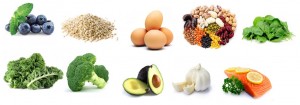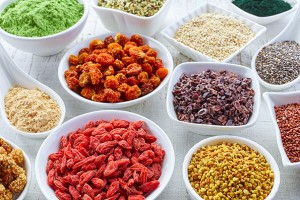What are Superfoods?
Superfoods have been making waves lately and are becoming more popular because of their nutritional content and health benefits. Although there are no set criteria, foods that have been elevated to superfood status include those that are rich in antioxidants, healthy fats, fibre, phytochemicals, polyphenols, vitamins, and minerals. Superfoods are believed to aid in weight loss, increase energy levels, improve skin and hair appearance, and reduce the risk of digestive issues. Their nutrients may also help reduce the risk of chronic illnesses such as cancer, diabetes, and heart problems. Here we take a look at some of the most popular superfoods and what’s so special about them that they have been labeled as “super”.
Top 10 Superfoods
Blueberries
They are a good source of Vitamin K, C, Fibre, Manganese, and the antioxidant Anthocyanin. A cup of blueberries contain 84 calories with 14% of the suggested daily fibre and 24% of the suggested daily intake of Vitamin C. Studies show that blueberries can lower blood pressure and bad cholesterol, speed up metabolism, reduce the risk of coronary heart disease, and even inhibit the growth of breast cancer cells. It also has the benefit of enhancing memory and learning function while reducing blood sugar and decreasing symptoms of depression. Blueberries are great eaten on their own or added to Greek Yogurt, Pancakes, Muffins and so on – the recipes are endless so get creative!
Quinoa
Also referred to as super grain, mother grain, or super crop, quinoa is probably the most popular among the superfoods. It acts like a grain but is actually a seed that is packed with fibre, protein, iron, and potassium. One cup of cooked quinoa has 8 grams of protein and 5 grams of fiber. It contains 222 calories with 58% RDA of manganese and 30% RDA of magnesium. Quinoa is usually grown organically and is gluten free. It can help fight diabetes and hypertension and is a natural appetite suppressant, making it one of the best superfoods for weight loss. Quinoa is a versatile superfood and is perfect for active people because it’s high-volume and relatively low-calorie.
Kale
Many people see kale as just a garnish normally placed around the plate or salad bar for decorative purposes. It might be surprising for some to realize that it is in fact edible and even considered as one of the superfoods. One cup of cooked kale only has 36 calories. It contains 90% of your daily Vitamin C, 192% of your daily Vitamin A, and over 900% of your daily Vitamin K. Kale’s nutrients are primarily antioxidants, anti-inflammatory, and anti-cancer. The organosulphur compounds found in this food have been proven to be highly effective against cancer. It is also packed with antioxidants such as beta-carotene, kaempferol, and quercetin. This is the reason why kale is one of the vegetables with the highest ORAC rating. ORAC stands for Oxygen Radical Absorbance Capacity, which measures foods’ ability to hunt and neutralize free radicals.
Broccoli
Cruciferous vegetables are known for their cancer-fighting properties but among all of them, broccoli is probably the best. It is the only one with a sizable amount of sulforaphane. This is a potent compound that boosts the body’s protective enzymes and flushes out cancer-causing chemicals. This component also targets cancer stem cells that aid in tumor growth. A cup of broccoli has only 34 calories. It contains over 100% of your recommended daily Vitamin C and K, and 21% of your daily Vitamin A. It is one of the superfoods included in the top 20 when it comes to the ANDI score (Aggregate Nutrient Density Index). This measures the vitamin, mineral, and phytonutrient content of food in relation to caloric content. With its wide nutritional profile, some of broccoli’s health benefits include improving bone health, digestion, eye health, and heart health.
Spinach
Spinach was already considered a power food even before the term superfood came into the picture. It contains more nutrients per calorie than any other food on the planet. One cup only contains 7 calories. It is packed with over 400% of your daily Vitamin K and about 47% of your daily Vitamin C. The phytonutrients in spinach are both anti-inflammatory and anti-cancer. Its rich vitamin K content is beneficial to bone health and is also needed for proper blood clotting. Spinach is one of the richest among the green leafy vegetables in terms of iron, which is needed by the body for red blood cell production. It also has antioxidant abilities with its Vitamin C and A content. Spinach can protect the eyes against diseases such as cataracts and macular degeneration due to the carotenoids it contains. When included as part of your regular diet, it may help prevent osteoporosis, anaemia, cardiovascular diseases, and some cancers.

Eggs
Eggs are best known as an alternative to meat for vegetarians. This is because it is an excellent source of protein. In fact, 12.5% of the weight of the egg is protein and is found in both the yolk and albumen. Egg protein has high biological value as it contains all the essential amino acids needed by the body. One large egg only has about 70 calories and contains 50% of your daily requirement of Vitamin B12. This vitamin helps protect against heart disease. Lack of vitamin B12 may cause anaemia, cognitive and mood disorders among others. Eggs are also rich in the two antioxidants lutein and zeaxanthine, which protect against eye diseases such as cataracts and macular degeneration. One other reason why eggs is one of the most popular superfoods is its ability to make you feel fuller and therefore eat less overall calories, aiding in weight loss. Studies show that this is specially effective when eggs are eaten at the first meal of the day.
Beans
Sometimes referred to as “poor man’s meat”, beans are another meat substitute because of its high protein, low fat, and low cholesterol make up. Half a cup of beans holds about 100 to 120 calories. They are loaded with Fibre, B Vitamins, Folate, Magnesium, and Iron. Although beans are comparable to meat in terms of calories, they stand out in its fiber and water content. These two ingredients make you feel fuller faster, helping you cut calories in your diet without feeling deprived. Beans are considered heart healthy because they contain soluble fiber, which can lower cholesterol and triglyceride levels. They have a low glycemic index and are digested slowly. This helps keep blood glucose levels stable. The abundance of fibre and antioxidants in beans may also help prevent several types of cancers. With all these benefits, it’s no wonder that the humble beans are included in the popular superfoods list.
Avocado
Avocado is considered a unique type of fruit since it is high in healthy fats while most fruits consists primarily of carbohydrates. 77% of the its calories are actually from fat, making it one of the fattiest plant foods on earth. The majority of the fat in avocados is oleic acid which is also the major component in olive oil. It is believed to reduce inflammation and may lower the chance of certain cancers. One avocado contains about 1/3 of the daily requirement of Vitamin K and Folate. Avocado is said to be good for sexual health and fertility. The Vitamin B6 and Folic Acid in this fruit regulates sexual hormone functions. While Vitamin B6 and Potassium boost testosterone production in males. Among the superfoods, avocado packs more potassium than bananas and is rich in fibre. It has about 7% of fiber by weight, which aids in weight loss and metabolic health.
Garlic
Garlic is a one of the most commonly used superfoods with its ability to flavor any type of dish. Most people overlook the amazing benefits that it can give our body. A cup of garlic can contain the recommended daily value of 95% Vitamin B6 and 52% Vitamin C. It is considered a natural antibacterial with 1% of the potency of penicillin and is useful in fighting off infections. Garlic also does a great job of lowering blood pressure and preventing blood clots in the body. It should be noted though that blood pressure will only be regulated after several weeks of including garlic in your diet. Other benefits of garlic in the body include lowering cholesterol and fighting off common colds. It helps regulate blood sugar level and act as antioxidants that boost the immune system. It is even known to protect against certain types of cancers and protect the liver.
Salmon
Salmon can be purchased in different varieties: either steaks or fillets, fresh or frozen, canned or smoked. What’s great about this fish is that it contains Omega-3 fatty acids which has tons of heart benefits. It helps reduce cholesterol, maintain flexibility of arteries and veins, strengthen cardiac muscles, and repair damages to the cardiovascular tissues. It can also reduce blood pressure and the chances of heart attack. Salmon has one of the highest levels of Vitamin D and B12 as well as provide protein to your body. Vitamin D plays a key role in bone health while Vitamin B12 is important for the normal functioning of the brain and nervous system. Salmon is beneficial to cardiovascular health, brain functionality, immune health, eye health, and the regulation of blood sugar levels.
 There’s a wide variety of superfoods you can choose from. You can choose from an array of everyday common foods that provide these nutrients or some exotic and less mainstream foods that are worth getting to know. You may have also heard of turmeric, chia seeds, flaxseeds, goji berries, and many more that are also considered superfoods with their own nutrient contents and health benefits. Superfoods are constantly evolving and every year we see new foods coming out as “super”. If you’re on the look out for new and trendy superfoods this 2016, check out this video! With all the different options out there, it’s just a matter of knowing each one’s nutritional value and how to fit them into your own diet. While these superfoods claim to have positive health benefits, nutrition experts agree that a diet based on a variety of nutritious foods is still the best way to ensure a balanced nutrient intake for optimal health.
There’s a wide variety of superfoods you can choose from. You can choose from an array of everyday common foods that provide these nutrients or some exotic and less mainstream foods that are worth getting to know. You may have also heard of turmeric, chia seeds, flaxseeds, goji berries, and many more that are also considered superfoods with their own nutrient contents and health benefits. Superfoods are constantly evolving and every year we see new foods coming out as “super”. If you’re on the look out for new and trendy superfoods this 2016, check out this video! With all the different options out there, it’s just a matter of knowing each one’s nutritional value and how to fit them into your own diet. While these superfoods claim to have positive health benefits, nutrition experts agree that a diet based on a variety of nutritious foods is still the best way to ensure a balanced nutrient intake for optimal health.